Goma is a gentle storyteller exploring the deep, unknown realms of time and space.
To me, he’s like an astronaut.
—Seiko Ito
Traveling back and forth to a world of light and expressing the ever-clearer images via paintings
Seiko: The last time we met was at your solo exhibition in Ebisu. The white-on-white expressions were a tremendous change from your past work. Did they come from a change of mood? Or a change in your hands maybe?
Goma: A change in the images I see. I still have aftereffects that take me to the afterworld, and a new image appears each time, during the process of regaining consciousness. By the time I completed the journey ten, twenty, and thirty times, the images became clear enough to study in more detail. Whereas I used to recall only the scene on the way back to this side, now I can remember the scene in a slightly deeper place.
Seiko: You mean you’re aware of what’s going on during those journeys?
Goma: Ever since I started making the effort to observe, something has seemed to remain in my head even after I regain consciousness. It’s a picturesque world both like and unlike a dream, a world of light that just stays stuck in place. I began seeing the white light two or three years ago. As far as I can tell, it’s the farthest I’ve been. The closer I come back to reality, the more the colors stand out—the reds and blues.
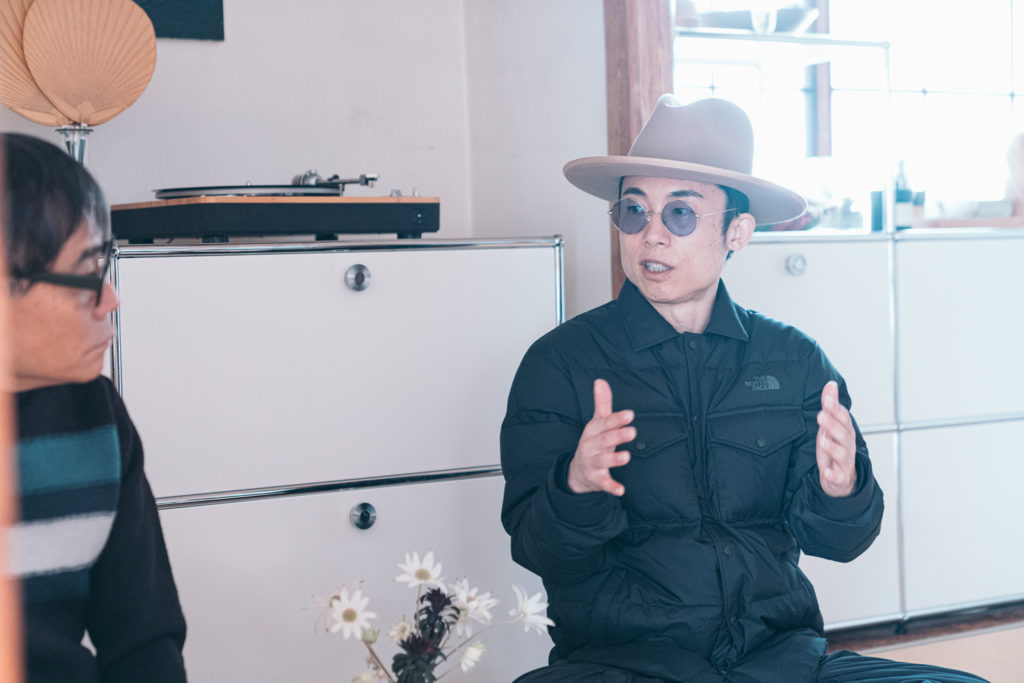
Seiko: So, is that light the afterworld?
Goma: If there’s an afterworld distinct from this world, then I think the light is the gateway. Beyond it is a deep place approaching death, and if I were to enter that zone, I might never be able to come back. What I’m seeing, though, is a small area much closer to life on this side.
Seiko: Do you feel any pain when you’re in the afterworld? Or maybe on your way back?
Goma: I don’t feel anything. It’s all fluid and integrated, like I can be anything and go anywhere.
Seiko: So, you’re free. You don’t feel any fear either?
Goma: If anything, I’d say I feel full of hope. After all, the light is what draws my consciousness back to this world. Once I’m back, I gradually regain consciousness and then stability.
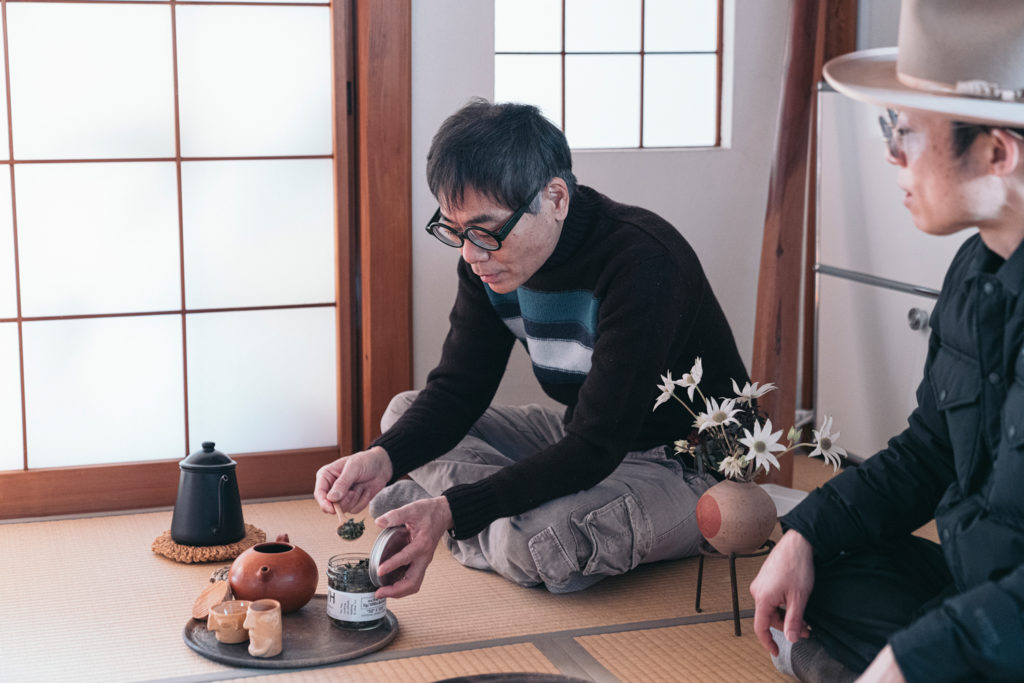
Leaping from executive dysfunction to savant
Seiko: From a medical point of view, the functions of the frontal lobe of your brain were paralyzed. Does that mean you had difficulty speaking?
Goma: That depends on which part is damaged. The frontal lobe is the brain’s control center. It sends signals to other parts of the body. If one nerve gets cut, you could lose the ability to talk, or if another, the ability to stand. In my case, I could see but not understand what I saw. Ordinary writing looked like hieroglyphs, for example. This condition used to last pretty much all day, but as different neural circuits began to form, I regained various functions. I was one of 300,000 to 400,000 people in Japan and millions around the world fighting executive dysfunction. We make up a new category of humans that didn’t existed on Earth before.
Seiko: What you’re telling me does sound like a whole new category.
Goma: Our kind wouldn’t have survived before. Medical advancements are helping more and more of us come back.
Seiko: But not all of you can paint, right? Each of you is different.
Goma: Apparently, it’s rare for a special talent to emerge from executive dysfunction. I only recognized my own ability three or four years ago, when an NHK documentary took me to the United States to meet a world-renowned brain expert. Until then, I wasn’t sure what was happening inside my own head. The doctor told me I had leaped over executive dysfunction and developed a condition called acquired savant syndrome. So he told me to brace up.
Seiko: Brace up for what?
Goma: I would never go back to living a normal life, so I should focus instead on honing my gift. The American researchers were studying cases like mine from around the world. They had found about a hundred at the time. From what they knew, our brains had once shut down and then restarted. Each of us acquired a different talent depending on the area of the brain that was damaged. The left side is responsible for calculation and speech, and the right side for sensory functions. In my case, the left side wasn’t working well because of the injury, so the right side developed to make up for the loss with sensory functions.
Seiko: What happens if it’s the other way around?
Goma: One savant I met in the US had become a math genius. He was originally just a typical party animal, but after regaining consciousness, he saw the world as numbers and began expressing that by drawing equations. One day, when he was drawing in a café, a physicist recognized his work as some kind of universal law.
Seiko: Encounters are important, aren’t they? That goes for you too, Goma. Filming the documentary helped you look at your situation objectively, and that encouraged you to observe what goes on in your unconscious.
Goma: That’s true. Up to then, I believed that one day I would get better and get over what happened. In fact, my body does seem to be moving more smoothly in the past ten years. But being told that my new condition was my only weapon in life helped me realize where I stood. It made me embrace my unique expressions and want to find a use for them in society.
Seiko: Wow. You made a comeback as “Shin Goma.”
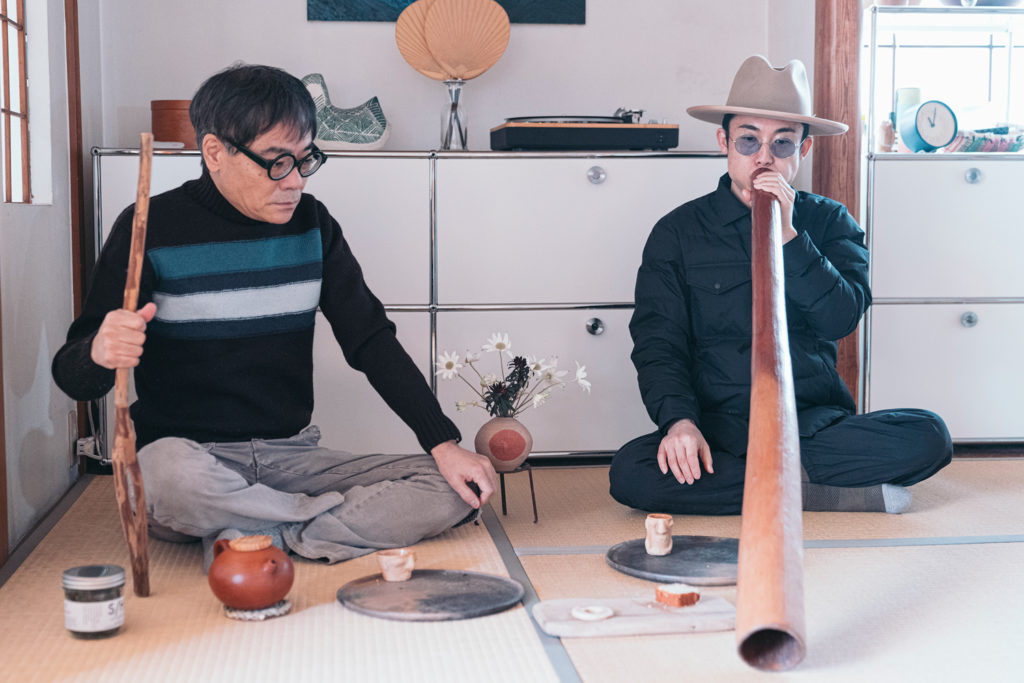
Revival of a phantom instrument
Seiko: Recently, when you performed with the Ainu people in a music festival, you talked about discovering an instrument similar to the didgeridoo that was traditionally used by the Ainu but had fallen into disuse, and a picture depicting that instrument.
Goma: Back when I was working at a didgeridoo shop in Australia, I heard from a cultural anthropologist that there was an instrument in Japan similar to the didgeridoo. For three or four years now, I’ve been helping to promote the Ainu culture in Kushiro, Hokkaido, and on my first trip there, I saw that instrument.
Seiko: It was your destiny calling.
Goma: It’s called the cirektekuttar. But unlike the tonkori or mukkuri or other traditional Ainu instruments, there weren’t any documents left about it or any hint as to how to play it. All I knew was that it was made of an indigenous plant to Hokkaido called Ezonyu, aka bear’s angelica. Because this plant was tough and readily available, I started doing some research. During that process, I discovered a picture diary on the Ainu people’s lifestyle by Matsuura Takeshiro, who drew the first map of Hokkaido, and in it was a picture of the cirektekuttar. I also found an elder from the generation when the cirektekuttar was actually used.
Seiko: You made the discovery just in time, before all of that was lost forever. I heard you play the cirektekuttar at the festival too. Is it too early to congratulate you on a revival accomplished?
Goma: That was more my style of playing than anything else. The cirektekuttar sounds quite similar to the didgeridoo, you know.
Seiko: The instrument wasn’t putting up any resistance though. It seemed to be shouting, “I’ve been wanting to make sounds so bad!” I was impressed and moved, also because you were fulfilling your mission in genres other than painting.
Goma: That’s true. I felt the need to fulfill my duty. When the Ainu people are able to do things like harvest the Ezonyu and tune the cirektekuttar unaided, then I would feel I played a part in reviving the instrument as part of their culture.
Seiko: When you think about it, contemporary Ainu music was missing a low-pitch element all along. It needed the cirektekuttar to be complete. Now that you’ve made sounds, it won’t be long before we can listen to the music in its original form. Talk about exciting. Keep it up and go on riding on all kinds of waves, Shin Goma!
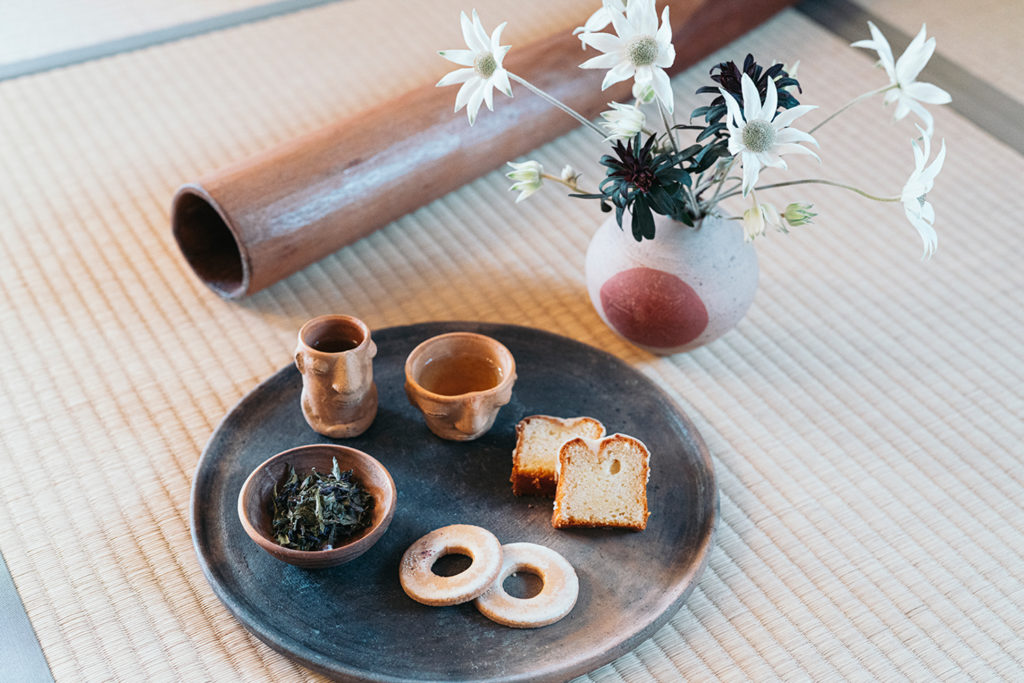
Japanese Fika Table
Tea | Black Peppermint (Sukumo Herb)
Tea brewed from chemical-free herbs grown in Sukumo City, Kochi Prefecture. The spicy aroma of black peppermint is blended with bancha tea and served in a teapot and mezcal cups from Mexico.
Sweet | Lemon cake & lemon cookies (Lemon and Camel)
Fermented organic sweets by fermented foods chef Yuki Kaneko. The semisweet baked confections made with yeast and the scent of lemon pair deliciously with herb tea.
Flower | Flowery Australian landscape
Refreshing white and green flannel flowers native to Australia—like the didgeridoo—arranged with spurges in a pot (used as a vase) by Yukiharu Kumagai.
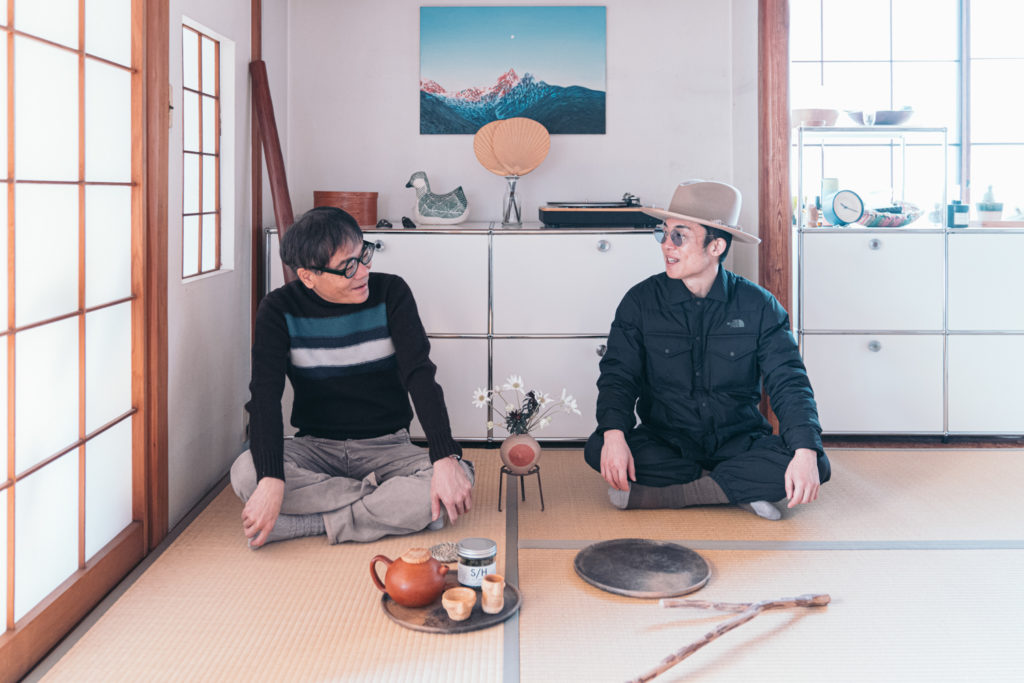
Goma, Didgeridoo Player & Painter
Goma was born in 1973 in Osaka Prefecture. In 1994, he discovered the didgeridoo, a wind instrument developed by Aboriginal Australians, and went on to train in Australia and become an internationally recognized didgeridoo player. His career was put on hold in 2009, when a car accident left him with executive dysfunction. Two days after the accident, however, he suddenly began churning out elaborate dot paintings, and with his freedom of composition and original sense of color, embarked on a career as a painter too. In 2018, he was diagnosed with acquired savant syndrome by Dr. Darold Treffert, a psychiatrist and world-renowned expert in savant syndrome. Goma currently works as a didgeridoo player and painter, and gives talks about his condition and experiences. Publications include the picture book Monad, with poems by Shuntaro Tanikawa.
Seiko Ito
Born 1961 in Tokyo, Seiko Ito is an author and creator who works in a spectrum of expressive genres including literature, film, stage, music, and online platforms. His latest publication is the book The Medicine called ‘LOVE’.











